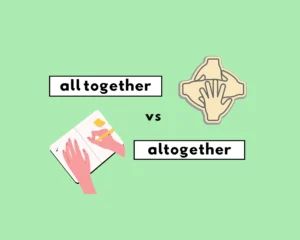In the intricate tapestry of the English language, subtle distinctions often lie beneath the surface, waiting to trip up even the most seasoned wordsmiths. One such pair of confounding terms that frequently tests the waters of precision is all together and altogether.
While they may sound similar and share a common origin, these expressions harbor nuanced differences that can significantly alter the meaning of a sentence.
Let’s go through the linguistic depths to unravel the intricacies of “all together” vs. “altogether,” exploring how the placement of a space can transform the context of communication.
All Together

All together is a phrase that denotes the collective presence or occurrence of things or people in one place or at one time. It emphasizes unity, simultaneity, or a shared experience.
Examples:
- Let’s sing all together.
- This suggests a collective effort, with everyone participating in the act of singing simultaneously.
- They arrived all together.
- This implies that a group of people arrived at the same time, emphasizing their unity in the arrival.
- The team worked all together to complete the project.
- Here, “all together” highlights the collaborative effort of the team, emphasizing that everyone worked collectively on the project.
- We sat around the table and had dinner all together.
- In this context, it conveys that everyone present sat together at the table and shared a meal simultaneously.
- During the performance, the musicians played all together.
- This illustrates the coordinated effort of musicians playing their instruments simultaneously during a performance.
Usage Tips:
- Use “all together” to emphasize unity, collaboration, or simultaneous action.
- It is particularly useful when describing activities involving a group of people or things acting in harmony.
- The phrase can be employed in both literal and metaphorical contexts to convey a sense of togetherness or collective involvement.
Altogether
Altogether is an adverb that means “completely” or “entirely.” When used in a sentence, it conveys the idea of totality or completeness, indicating that something is considered as a whole without any exceptions.
Examples:
- I am altogether happy.
- In this example, “altogether” emphasizes that the speaker is completely and entirely happy, leaving no room for any mixed feelings.
- The plan was altogether unsuccessful.
- Here, “altogether” suggests that the plan failed entirely, with no aspect of it being successful.
- She decided to resign altogether.
- This indicates that the person decided to resign completely, without any intention of maintaining a partial association with the job.
- The project was altogether more challenging than we anticipated.
- In this case, “altogether” emphasizes that the project was entirely, or completely, more challenging than initially expected.
- The meal was altogether delicious.
- This conveys that every aspect of the meal was tasty, and there were no exceptions; it was entirely delicious.
Usage Tips:
- “Altogether” is often used to stress the completeness or entirety of a situation, feeling, action, or state.
- It is useful when you want to emphasize that there are no exceptions or partial aspects involved.
- Be cautious not to confuse “altogether” with “all together.” While “altogether” means entirely, “all together” refers to things or people being collectively in one place or at one time.
Key Differences
“All together”: Refers to things or people being collectively in one place or at one time, emphasizing unity or simultaneity. It highlights a collective or simultaneous action.
“Altogether”: Functions as an adverb meaning “completely” or “entirely.” It indicates a sense of totality, emphasizing that something is considered as a whole without any exceptions.
Usage:
- “All together”: Used to describe activities involving a group of people or things acting in harmony. It can be applied in both literal and metaphorical contexts to convey a sense of togetherness or collective involvement.
- “Altogether”: Employed when you want to stress the completeness or entirety of a situation, feeling, action, or state. It is used to indicate that something is done entirely, leaving no room for partial aspects.
Context:
- “All together”: Often used in the context of collective actions, gatherings, or events where people or things are united in one place or happening simultaneously.
- “Altogether”: Applied in various contexts to convey the idea of completeness. It can be used to describe feelings, actions, decisions, or assessments that are entirely and completely done.
Examples:
- “All together”:
- “Let’s sing all together.”
- “They arrived all together.”
- “The team worked all together to complete the project.”
- “Altogether”:
- “I am altogether happy.”
- “The plan was altogether unsuccessful.”
- “She decided to resign altogether.”
Caution:
- Be mindful of the spelling and context to ensure the correct usage. “All together” and “altogether” have distinct meanings, and using one in place of the other can lead to confusion in communication.
Common Mistakes and Misuse

Common mistakes and misuse often occur when “all together” and “altogether” are confused due to their similar spellings. Here are some scenarios where these phrases might be incorrectly interchanged:
- Unity vs. Completeness:
- Incorrect: “They sang the song altogether.”
- Correction: “They sang the song all together.”
Explanation: In this example, “altogether” is mistakenly used, but the correct phrase is “all together” because it refers to the unity of people singing together.
- Totality vs. Simultaneity:
- Incorrect: “I am altogether pleased with the results.”
- Correction: “I am all together pleased with the results.”
Explanation: The correct usage is “all together” to emphasize being pleased with the results as a whole, not using “altogether,” which would imply being completely pleased.
- Complete Action vs. Collective Action:
- Incorrect: “The team worked altogether to finish the project.”
- Correction: “The team worked all together to finish the project.”
Explanation: “All together” is appropriate when emphasizing the collective effort of the team working simultaneously, whereas “altogether” would imply a complete action rather than teamwork.
- Completely vs. Simultaneously:
- Incorrect: “The conference participants arrived all together.”
- Correction: “The conference participants arrived altogether.”
Explanation: Here, “altogether” should be used to convey that the participants arrived completely, without exception.
- Entirely vs. In One Place:
- Incorrect: “We sat altogether around the table.”
- Correction: “We sat all together around the table.”
Explanation: “All together” is appropriate to describe people sitting in one place, while “altogether” refers to being entirely happy, pleased, etc.
- Misuse in Expressing Happiness:
- Incorrect: “I am all together happy with the outcome.”
- Correction: “I am altogether happy with the outcome.”
Explanation: In this case, “altogether” correctly emphasizes complete happiness.
To avoid these common mistakes, it’s crucial to pay attention to the intended meaning of unity and simultaneity (“all together”) versus completeness or entirety (“altogether”).
Tips for Proper Usage
Here are some tips to help remember the correct usage of “all together” and “altogether”:
- Unity vs. Completeness:
- “All together”: Use when referring to things or people being collectively in one place or at one time. Think of it in terms of unity or simultaneity.
- Totality vs. Simultaneity:
- “Altogether”: Use when you mean “completely” or “entirely.” Consider it as emphasizing the totality of something without exceptions.
- Complete Action vs. Collective Action:
- “All together”: Appropriate when emphasizing a collective action, such as a group working or singing simultaneously.
- Completely vs. Simultaneously:
- “Altogether”: Choose this when you want to convey that something is done entirely, leaving no room for partial aspects.
- Entirely vs. In One Place:
- “All together”: Use when describing things or people being in one place at the same time. It emphasizes togetherness.
- Misuse in Expressing Happiness:
- “Altogether”: Correct when expressing complete happiness or satisfaction. “I am altogether happy.”
- Remember the Adverb:
- “Altogether”: Recall that it functions as an adverb, indicating the degree or extent of an action.
- Mind the Space:
- “All together”: Note the space between “all” and “together.” This helps distinguish it from “altogether.”
- Think Simultaneous Action:
- “All together”: If the sentence involves people or things doing something at the same time or being in the same place, opt for “all together.”
- Consider Completeness:
- “Altogether”: If the focus is on the entirety or completeness of an action, feeling, or state, use “altogether.”
Remembering these distinctions and practicing with examples can reinforce the correct usage of “all together” and “altogether” in different contexts.
Conclusion
All together and altogether may appear similar, but they serve distinct purposes in language usage. “All together” emphasizes unity and simultaneity, often describing collective actions or gatherings, while “altogether” functions as an adverb, denoting completeness or entirety.
To use them correctly, remember that “all together” refers to things or people being collectively in one place or at one time, while “altogether” conveys the idea of something being done entirely or completely. Pay attention to context and the specific nuance each phrase brings to ensure accurate communication.

